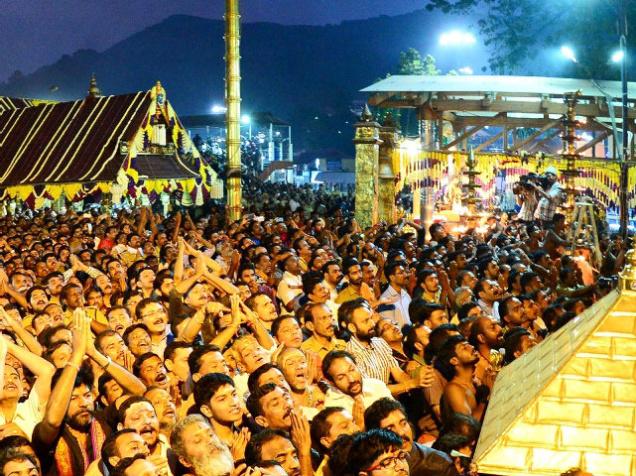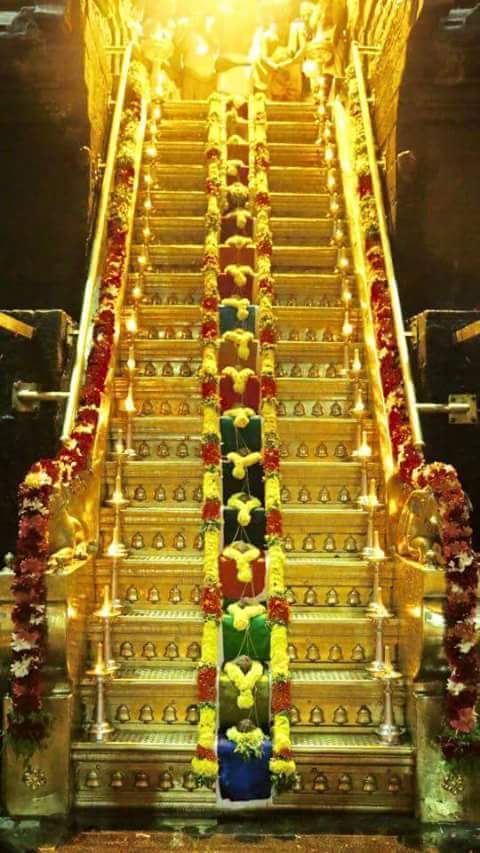The Importance of Sabarimala Pilgrimage
The Sastha temple is one of the ancient temples in Kerala and it is widely believed that the deity of this temple was installed by Parasurama. According to another very popular legend, it was Parasurama (an incarnation of Lord Vishnu) who created Kerala. When he threw his axe into the sea, the water receded. The land thus he reclaimed from the sea came to be known as Kerala. This is such a popular legend that almost every other legend related to Kerala has some association or other with this. Sabarimala (the hill where Sabari, a pious woman, observed austerities) has been mentioned even in the Ramayana. Ramayana also has a reference to Sastha; however, there is no mention of Ayyappan.

Ecstatic devotees watching Makaravilakku
A typical Sabarimala pilgrimage season starts in the middle of November (on the 1st of Vrushchikam) and ends on the first of Makaram (January 14 or 15). During these two months millions reach the shrine of Ayyappan seeking his blessings.
The Sabarimala Sashta Temple is located on the slope of Western Ghats in the Pathanamthitta district of Kerala.
The significance of the pilgrimage and Lord Ayyappa
Ayyappa has played a significant role in ensuring communal harmony in Kerala. His shrine is open to all. In fact, it even houses a shrine to a Sufi saint. Another very important aspect of this pilgrimage is its emphasis on the equality of human beings. Whether you are rich or poor, you are required to observe the same austerities. You are required to wear the same clothes, walk barefoot and address each other as Ayyappa or Swami. Regardless of your social or financial status, you are all equal before Ayyappa. The Lord sees no distinction between a rich devotee and a poor devotee and He doesn’t want his devotees to see any such distinctions among themselves either.
Ayyappan and his devotees (who are also addressed as Ayyappans) enjoy cult status in South India. Almost every Hindu home has at least one Ayyappan (devotee). Even the public treats them with utmost respect. Once they start wearing the black or blue clothes and a chain of beads around their neck, they become the God Himself.
Ponnu Pathinettampadi (The Holy 18 Steps)
 After ascending the hills and reaching Sannidhanam (the abode of Ayyappa), a pilgrim has to climb 18 steps to reach the shrine. These 18 steps are so important that they are celebrated in all the songs and folklores about Ayyappa and the temple. In Malayalam ‘ponnu’ means ‘gold’. Ponnu Pathinettampadi literally translates to ‘golden eighteen steps’. These steps are covered in an alloy of five metals (panchaloham) and have a golden glow to them.
After ascending the hills and reaching Sannidhanam (the abode of Ayyappa), a pilgrim has to climb 18 steps to reach the shrine. These 18 steps are so important that they are celebrated in all the songs and folklores about Ayyappa and the temple. In Malayalam ‘ponnu’ means ‘gold’. Ponnu Pathinettampadi literally translates to ‘golden eighteen steps’. These steps are covered in an alloy of five metals (panchaloham) and have a golden glow to them.
Each one of these holy steps is said to represent a desire one must conquer in life. Only those pilgrims who ascend the hills carrying irumudikettu (two cloth bundles carrying offerings for the Lord) on their head after observing austerities for 41 days can climb the 18 steps.